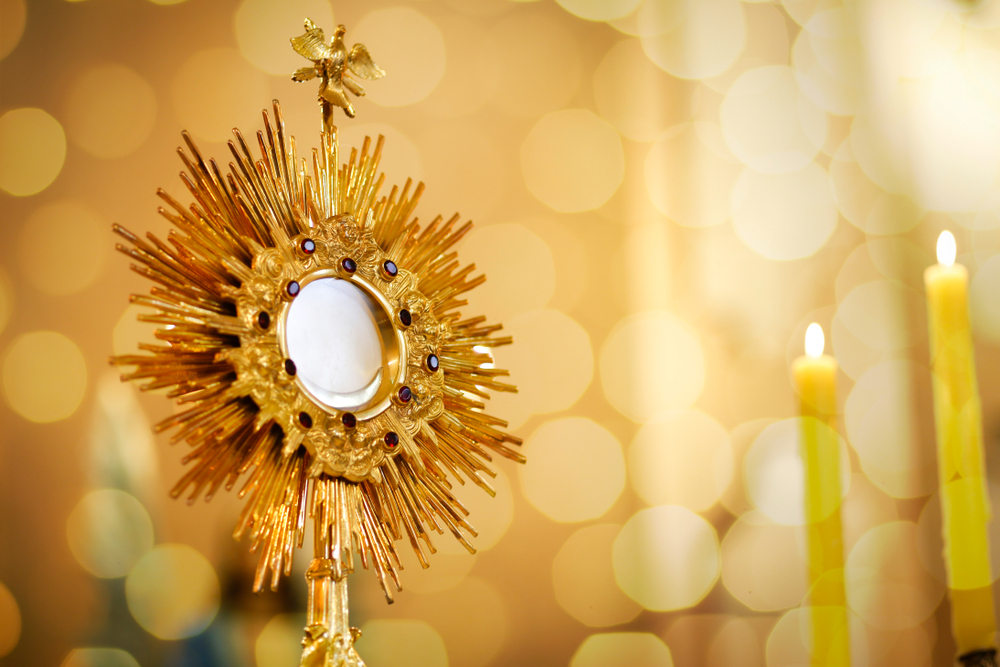If you’re intimidated by the idea of bringing younger children (or even teens) into a quiet Eucharistic adoration chapel…or even to pray before the tabernacle…then take heart: Many parents are already taking their children along to Eucharistic adoration, with good results.
Kimberly Fries says her husband brings their five-year-old daughter to adoration on a regular basis. “It is seriously the highlight of her week! She loves playing adoration with our family alter, too! She just brings her rosary and a book. Sometimes she just wants to sit and look at the Eucharist, other times she gets a little antsy, so he lets her go to the little library right next to the chapel and pick out another book. He said it doesn’t really affect his prayer either because she knows how to sit well at this age.” She and her husband even bring their three-year-old daughter, who “knows what to do,” even if she isn’t able to stay for too long.
Eucharistic adoration is the practice of praying before Jesus in the form of the Eucharistic host. The host may be exposed in a special vessel known as a monstrance, or reserved in a tabernacle. (The tabernacle is the place where the Eucharistic hosts are kept after the celebration of Mass; it is indicated by a light or candle.)
Many larger Catholic communities sponsor perpetual (around-the-clock) adoration before the exposed Eucharist in a special chapel that is open to the public. Sometimes parishes will hold a more limited time of Eucharistic adoration (such as the Forty Hours Devotion), especially during holy seasons.
Where perpetual Eucharistic adoration is available, individuals are invited to sign up for a regular hour. However, adoration is also open to anyone who wants to come and spend time in the presence of the Blessed Sacrament.
People pray in all sorts of ways during Eucharistic adoration.Meditative Prayer, Contemplative Prayer, and silent conversation with Jesus are common practices, as is saying the rosary (see Pray the Rosary). Some people sing hymns of praise (if they are alone), while others write in a prayer journal or bring sacred reading. But Eucharistic adoration can also be as simple as sunbathing . . . just sitting and soaking up God’s love in the presence of Jesus.
Younger children (ages 3-6)
Recalling Jesus’ command to “let the little children come to me” (Matthew 19:14), many Catholic parents bring even very young children, including infants and toddlers, to Eucharistic adoration. Because young children may be distracting to other people, however, check with your pastor or the person responsible for organizing adoration hours to see whether the practice is generally accepted in your parish.
Avoid bringing food or noisy toys into the adoration chapel; however, you might bring religious picture books or crayons and religious coloring sheets. If you are lucky enough to have the chapel to yourselves, you can lead your children in a modified version of the rosary or in singing religious songs.
Older children and teens (ages 7+)
Pope Benedict XVI recommended that children be taught to appreciate spending time in the presence of the Eucharist as part of their preparation for First Communion (Sacramentum Caritatis #67). Here are some tips for introducing children to this practice:
► Teach your children about the real presence of Christ in the Eucharist. See the Talking Points under Celebrate the Eucharist, or Catechism of the Catholic Church #1373-1381.
► Take your children to Mass regularly. The celebration of the Eucharistic liturgy is the “source and summit of Christian life” (Catechism #1324); Eucharistic adoration flows from the Mass.
► Practice reverence for the Eucharist. Genuflect and make the Sign of the Cross before the tabernacle in church, and by saying a prayer when you pass a Catholic church.
► Keep it short. Keep your first visits to the Blessed Sacrament short—say, ten minutes. If Eucharistic adoration becomes a regular practice for your family, you can gradually increase the time.
► Offer aids to prayer. Give your children a rosary, children’s prayer book, or a journal for writing down their prayers to Jesus.
► Teach children that reverence for the Eucharist doesn’t end in the adoration chapel. The Eucharist incorporates us into the Body of Christ and strengthens us to continue Jesus’ mission in the world, especially among the poor (Catechism #1397).
Talking points: Why Eucharistic adoration?
Children (and some adults) might wonder why Catholics practice devotion to the Eucharist; after all, isn’t God present always and everywhere?
While it is true that we can pray to God anywhere, the Eucharist holds a privileged place in Christian worship because in it, Christ is fully present: body and blood, soul and divinity (Catechism #1374). Think of it this way: In his love, God wants to be as close to us as possible; this is why he became incarnate—flesh and blood—in Jesus. But even as he was preparing to leave us in that form, he wanted to continue to remain physically, intimately present with us, so he gave us the Eucharist (Catechism #1380). And it is through the Eucharist that we become the Body of Christ, the Church, thus continuing his physical presence and his mission in the world.
More in the Catechism
Catechism of the Catholic Church #1378-1379,



